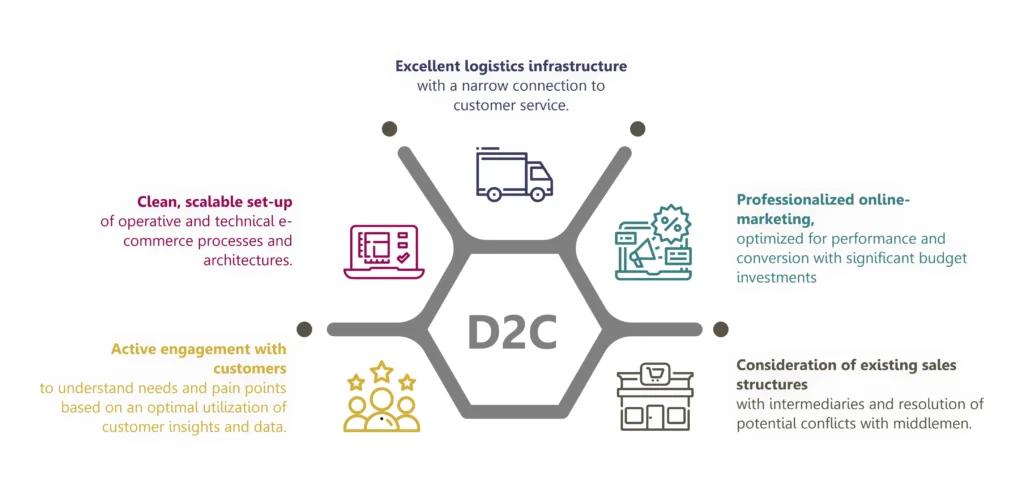Navigating the Digital Shift: The Rise of Direct-to-Consumer Models
The rapid expansion of e-commerce over the past years has cemented its role as a vital resource for businesses adapting to an increasingly digital world. The COVID-19 pandemic significantly accelerated the shift to e-commerce, especially as lockdowns in 2020 limited physical shopping, pushing diverse consumer segments online. This surge in online shopping not only opened new sales channels but also highlighted e-commerce as a tool for building economic resilience amidst challenging market conditions.
While e-commerce in general has risen in significance, one approach stands out: Direct-to-Consumer (D2C) models. This new sales strategy offers excellent opportunities for building close relationships with customers, navigating brand strategy and innovation with data-driven foresight, and realising higher margins. It’s no wonder that this e-commerce approach currently represent one of the most promising sales strategies, especially in the B2C area. According to a recent study by ECC Cologne in collaboration with Publicis Commerce Germany, every second customer in Germany is a D2C buyer.
While Direct-to-Consumer has become a reality in consumer markets, B2B companies are still lagging behind in realising its potential as a purchasing channel that can accelerate growth. This article explores why Direct-to-Consumer is now more relevant than ever in the B2B environment, what advantages its adoption may bring, and which success factors must be considered to exploit its full potential.
Challenging waters for B2B companies
In the current market environment, B2B companies face a multitude of challenges that underscore the critical need for adopting Direct-to-Consumer strategies. Raw materials scarcity, supply bottlenecks, and price pressures are putting immense strain on relationships between suppliers and their customers. Increasing competition necessitates accelerated efforts for customer retention. However, complex, multi-level sales structures at many B2B companies hinder direct engagement with end customers. This leads to not only lost margins at intermediaries but also unresolved customer issues that never reach manufacturers.
At the same time, not only market conditions but also customer requirements are becoming more demanding. The proliferation of global marketplaces and e-retailers has elevated the importance of multi- and omnichannel commerce. Customers now prefer selecting products from a wide array of platforms, which makes digital channels increasingly vital for B2B procurement. While B2B customers previously engaged with up to five channels in 2016, they now consistently use ten or more channels to interact with manufacturers, according to a study by McKinsey.
Additionally, in the consultancy-intensive B2B environment, customers now demand closer relationships with suppliers across various channels more than ever. Having a direct and personal line to the manufacturer for addressing queries and finding solutions, along with creating a holistic customer and purchase experience, becomes paramount to success. While customer expectations spike, their loyalty to specific suppliers simultaneously declines.
In this challenging environment, adopting an efficient, flexible, and customer-centric sales strategy may be key to economic resilience. But what exactly does D2C entail?
Defining D2C
Direct-to-Consumer modernises the traditional practice of direct sales by leveraging digital tools. It involves manufacturers selling their products or services directly to end customers, bypassing intermediaries. The contemporary significance of D2C lies in its digital execution, primarily through company-owned online shops or other digital touchpoints such as marketplaces. A company’s strategy, products, and customer base determine the choice of platform.
Though commonly seen as just a sales model, Direct-to-Consumer rather represents a digital business model. It introduces complexity while unlocking potential, fundamentally reshaping a business’s strategic direction and sales operations. For manufacturers, this approach involves creating their own distribution channels, taking comprehensive control over the supply chain, and establishing robust infrastructure and communication channels for direct customer interactions. This shift necessitates rethinking the entire customer journey to deliver seamless, end-to-end experiences.
Strategic advantages of D2C for B2B brands
The essence of Direct-to-Consumer is building strong, valuable relationships with customers throughout their entire journey—from initial interest to post-purchase and product use. This includes addressing all challenges during product ownership and use, and ultimately increasing Customer Lifetime Value. No retailer can do this better than manufacturers who know their products way better and are capable of offering more personalised and valuable experiences to customers. By adopting this sales models, B2B companies can shape the transactional moment of the customer journey themselves and close the gap to a more seamless customer journey.
Enhanced Customer Insights
Digital means data. And data is one of the most valuable assets in e-commerce. D2C approaches enable direct data collection and analysis of first-party data at the digital touchpoints. This provides a 360° view of customer behaviour, satisfaction, and sales patterns. By understanding what customers buy, why they buy – or return items – helps manufacturers develop action plans for improving marketing strategies, touchpoints and targeting. This also allows for more personalised offerings tailored to individual customer needs, revealing cross-selling and upselling opportunities often missed in non-D2C models.
Example: An industrial safety equipment manufacturer utilises data insights from its platform to analyse buying patterns. They discover that customers purchasing helmets frequently browse gloves but rarely complete the purchase. Responding to this insight, the company strategically recommends gloves at checkout to customers who add helmets to their carts, successfully increasing average basket volumes by promoting a complete safety solution.
Improved Brand Control
D2C models grant companies complete control over their supply chain and the entire brand experience. Traditional sales structures involving multiple layers often restrict how much influence a company can exert over intermediary interactions with customers, which can dilute brand messaging. Distributors, lacking deep product knowledge, might not deliver positive customer experiences. By adopting a direct sales approach, manufacturers take charge of communicating brand benefits and ensuring high-quality service, which strengthens the brand image and ensures a consistent experience at every customer touchpoint. Furthermore, direct interactions with customers facilitate a more effective response to their specific needs.
Example: A manufacturer of industrial adhesives shifted to a D2C model to ensure consistent messaging. Previously, distributors often overlooked promoting the adhesives’ superior heat resistance, which is critical for customers in high-temperature industries. By managing sales directly online, the company now ensures all communications highlight this key benefit, enhancing customer understanding and satisfaction with the brand’s specialized solutions.
Intensified Customer Relationships
D2C fosters more direct, long-term partnerships with customers. Despite a higher willingness to change suppliers in today’s market landscape, it enables a more targeted approach, leading to solutions that are better adapted to individual customer requirements. Do decision-makers need general information or data to convince others in the decision-making process? Do they need troubleshooting or an introduction to the product? Especially consultancy-intensive customers can benefit from more individual guidance via platforms, ultimately increasing customer satisfaction and loyalty, resulting in higher conversion rates and repeat purchases.
Example: A B2B supplier of specialized industrial coatings develops an interactive online platform where customers can input their specific requirements, such as resistance to certain chemicals or temperatures, and receive customised product recommendations. This hands-on approach not only solves specific customer problems but also builds stronger relationships by demonstrating a deep understanding of their unique industry challenges.
Agility in Evolving Markets
In a business environment with demanding and volatile markets, a fast-shifting economic climate and destabilised supply chains, an agile reaction and adaption to market changes is crucial. With a D2C sales strategy, companies can leverage more flexible adaption of product offerings and distribution strategies. Innovative product line extensions, subscription-based business models or digital services of manufacturers can be more easily integrated into the existing offering structure. In addition, adjustments of the existing portfolio based on customer feedback or the promotion of products to react to inventory build-up provide valuable flexibility and accelerated efficiency in the sales strategy.
Example: A commercial construction materials manufacturer used a D2C strategy to swiftly respond to evolving sustainability standards. Through direct feedback on their online platform from construction firms, they identified a demand for eco-friendly insulation materials. They quickly developed and introduced this new product line, aligning their production with market demands and regulatory changes, thereby optimising inventory and preventing overstock.
Cost Efficiency and Streamlined Sales Funnel
Ultimately, D2C provides significant cost advantages compared to classical multi-layer sales structures. The most obvious reason for this lies in the removal of intermediaries. Without distributors, B2B companies can significantly reduce overhead and transaction costs, hence improving margins as revenues are not shared with middlemen. Moreover, the relative cost of marketing can be reduced. With existing digital channels in place, existing customers can be re-activated most cost efficiently with targeted, data-driven approaches. The customer relevance is high and there are no additional budgets for media or performance marketing needed.
Example: A precision machining tools manufacturer switches to a D2C model, cutting out distributors to significantly reduce overhead and transaction costs. Using their online platform, the company launches automated marketing campaigns targeted at existing customers, promoting upgrades and complementary products. This direct approach revitalises customer engagement without extra marketing spend and enhances sales margins by avoiding distributor mark-ups.
Success factors for Direct-to-Consumer models
Having explored the numerous strategic advantages of Direct-to-Consumer models for B2B brands, we now turn our focus to the essential factors that drive its successful implementations. The following graphic outlines the critical components necessary for optimising D2C operations, ensuring that businesses can fully leverage their direct engagement with customers.

Conclusion
The adoption of Direct-to-Consumer models presents a promising future for B2B companies looking to navigate the complexities of an increasingly digital marketplace. As businesses continue to adapt to evolving customer expectations and market dynamics, this approach will likely become even more integral to their strategies.
You are currently exploring the benefits of digital business models or consider digitising your marketing processes? Get in touch with us about your requirements here.



